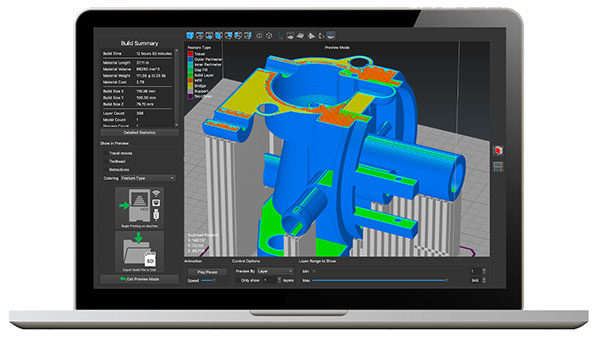
Streamlined user interface. Image courtesy of Simplify3D.
Latest News
January 9, 2023
Simplify3D has released Simplify3D Version 5.0—the 5th major version of its build preparation software. Version 5.0 contains more than 120 features and improvements including a next-generation slicing engine, integrated print optimizations and a feature-packed user interface, the company reports.
Accelerated Workflows
Version 5.0 starts with a streamlined user interface optimized for efficiency. Integrated toolbar layouts bring common controls into view with customizable keyboard shortcuts that enable fast access to the suite of features. Navigating through the 3D environment is more intuitive with advanced zoom and rotation controls that make it easy to inspect the smallest details.
3D mouse support provides a new way to interact with the application using familiar equipment. Live tracking of 3D model files keeps geometry in sync by automatically detecting changes to the CAD design and updating parts in Simplify3D. Support structure editing is upgraded with new tools to rapidly add or remove large regions of support with a single click. The printing process has become easier with added Wi-Fi and Ethernet machine communication to monitor and control 3D printers from afar.
Next-Gen Build Processing
There is a next-generation slicing engine in Version 5.0 packed with advanced capabilities. Agorithms provide performance improvements faster than Simplify3D V4. Many common mesh errors are now automatically repaired during processing. Targeting capabilities allow customers to isolate specific scenarios or patterns during the print and apply precise customizations to improve the end results.
Examples of targeting include adjusting interior hole tolerances separately from external outlines, printing small perimeters at reduced speeds for improved quality, reinforcing weak features with stronger infill parameters, or adjusting high flow rate regions to prevent clogs.
A streamlined settings interface gives access to all the new configuration options with the ability to search for settings by name, automate common settings changes, and compare settings profiles to highlight the most important differences.
Automated Layer-by-Layer Optimization
The software analyzes prints layer by layer. Adaptive Layer Height uses 3D model topology to dynamically adjust layer thickness. Automated Seam Hiding reduces surface defects by choosing the optimal location to begin each toolpath hiding start points from view. Dynamic Infill Density automatically increases the infill percentage near the top of the part creating improved top surfaces.
A collection of new 3D infill patterns create morphing internal structures that add increased lateral strength by varying the pattern on each layer.
Sources: Press materials received from the company and additional information gleaned from the company’s website.
Subscribe to our FREE magazine, FREE email newsletters or both!
Latest News
About the Author
DE’s editors contribute news and new product announcements to Digital Engineering.
Press releases may be sent to them via [email protected].





